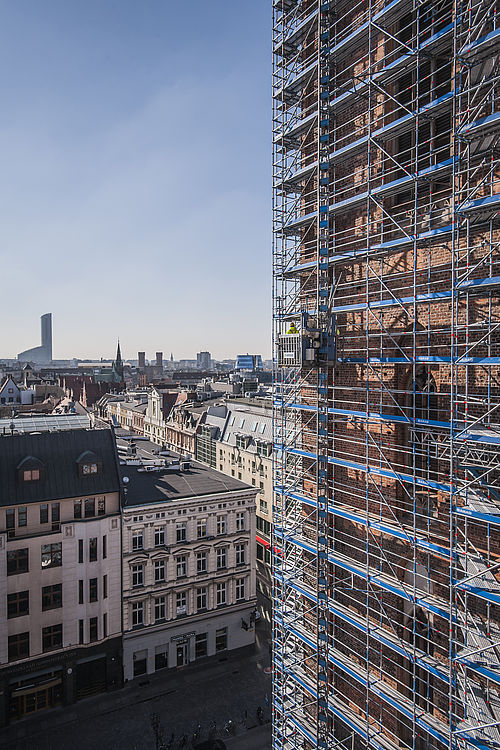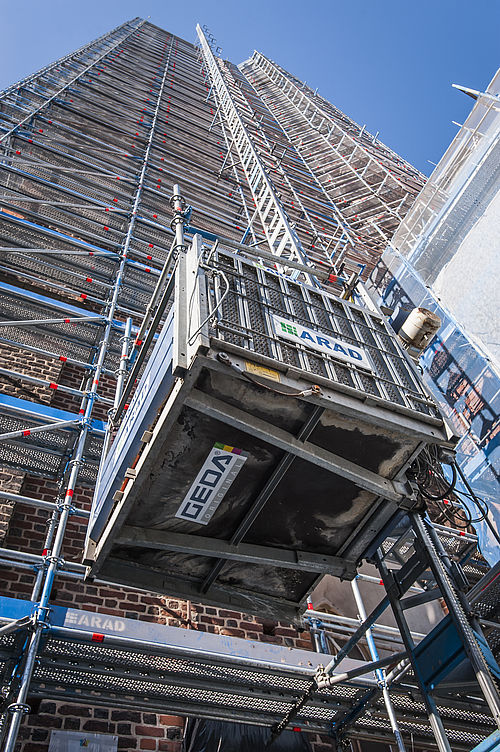To heavenly heights
GEDA material hoist solutions overcome challenges in the restoration of the Garrison Church in Wrocław
As one of the city’s two early Parish Churches, St. Elizabeth's Church built in the middle of the 14th Century is the landmark building of the Polish city of Wrocław. Located in the Hauptmarkt in the Wrocław old town, the three nave basilica built in the redbrick Gothic style, is a real tourist magnet. With an internal seating capacity of 2,000, the structure is one of the biggest churches in Silesia.
Renovation work on the historic church has been carried out several times over the centuries.
Wind and weather have afflicted the masonry and during the 17 and 19th centuries the supporting columns repeatedly fell down. Exterior refurbishment works on St. Elizabeth's Church between 1890 and 1893 fitted the church with a new chequered tiled roof. The last comprehensive renovation was carried out after a fire in the summer of 1976 in which large parts of the interior fittings, including the organ, the roof trusses and the ribbed vault were destroyed.
Nevertheless, the ravages of time continue to gnaw at the venerable church building so the Garrison Church is now hidden behind scaffolding once again.

Challenging renovation project
The Wrocław Garrison Church project is a huge challenge for all those responsible. The confined space conditions due to the church nave being located next to the church tower and the presence of other neighbouring buildings have meant that about 50 percent of the necessary 12,000 m² scaffolding surface had to be installed as suspended scaffolding over the adjacent roofs.
In order to ensure optimum logistics on the construction site, the local construction company responsible enlisted assistance from the hoist solutions manufacturer GEDA-Dechentreiter GmbH & Co. The rental company ARAD has been purchasing the Bavarian construction hoists since 2008 through the company High-Tech Polen. The devices are being used in two areas on St. Elizabeth’s Church. “We are using two GEDA Maxi 120 S wire rope hoists to construct the scaffolding up to a height of 30 metres and for the renovation of the church tower a GEDA 500 Z/ZP transport platform has been installed which transports the craftsmen and all the building materials easily, quickly and above all safely to the lofty heights of their place of work,” explains Sebastian Blonski, a board member of the company ARAD.
Dual scaffolding assistance
With two hoisting speeds, overload protection and slack rope switch, as well as numerous load suspension devices, the compact scaffolding hoist is the ideal tool for transporting scaffold components and various building materials efficiently yet still safely. The GEDA Maxi 120 S is being used by scaffolders, roofers and painters etc. for transporting materials efficiently along the scaffolding.
The manual drive of the rope drum is not transported upwards, but simply fastened to the scaffolding at the bottom, while the lightweight swivel arm is attached at the top of the scaffold at the desired height. The GEDA Maxi 120 S hoists offer great advantages primarily thanks to quick assembly and rapid implementation. The maximum working height is 70 m with a load capacity of 120 kg.
The integrated limit switch turns it off automatically on reaching the outrigger, when overloaded or caught on the scaffold.
Sebastian Blonski is convinced about the compact construction tools: “The two GEDA Maxi 120 S scaffolding hoists have played a huge part in enabling us to install the scaffolding as easily and quickly as possible which in turn has meant that we have been able to spend more time on the actual renovation work on St. Elizabeth’s Church.”

GEDA 500 Z/ZP – A modular system and easy assembly
Located in the southern part of the Church the huge tower built in the 16th century at a height of 130 metres was once of the highest structures of its era. Today – following reconstruction after a fire – the new tower built in Renaissance style measures about 90 metres.
According to Sebastian Blonski the vertical deviations in the geometry of the centuries-old tower were a true challenge for the height access technology installed on-site. Also the location of the church in the heart of the centre of Wrocław with the corresponding high traffic volumes around the building required construction site logistics that were finely-tuned to the local circumstances. “Using the GEDA 500 Z/ZP transport platform has enabled us to organise the people and construction materials easily, safely and quickly,” continued Blonski.
The 500 Z/ZP transport platform is an indispensable aid for the assembly of scaffolding as well as for the subsequent tasks on the construction site. Due to minimal space requirements, high load bearing capacity and numerous modes of usage, the construction hoist saves time and guarantees optimum logistics in construction. A lifting speed of 24 m/min in material mode and 12 m/min in passenger mode ensures rapid construction progress. The device has two separate controls enabling it to be utilised simply as a construction hoist with a payload of up to 1000 kg and as a transport platform for five passengers and loads of up to 500 kg.
No construction site is the same as any other. Therefore, the various platform versions with different loading doors and flaps have ensured an optimum adaptation of the GEDA 500 Z/ZP to the conditions on-site, which has proven to be of immense benefit given the restricted space around the church in Wrocław. The spacious loading platform, opening upwards, provides sufficient space for all types of construction materials.
GEDA has been setting new standards for decades both in quality and in safety. Thus, the GEDA 500 Z/ZP is naturally equipped with the usual safety equipment such as limit switches, speed-dependent safety gear, safety stop and overload protection.
The renovations are still ongoing
After the end of the Second World War, St. Elizabeth's Church was initially used by the Polish protestant lutheran church as a parish church, but was seized on 2 July 1946 and handed over to the military ordinariates of the roman-catholic church as a garrison church. It still has this function today.
The renovation works are currently still in full swing. Tourists from across the world will still have to be patient for a few more months before St. Elizabeth’s Church removes its “scaffolding sheathing” to reveal her former glory once again.




 Download as PDF
Download as PDF Print page
Print page